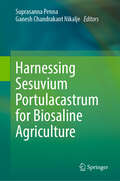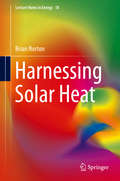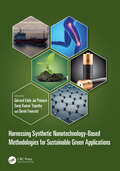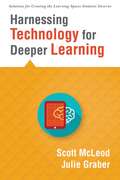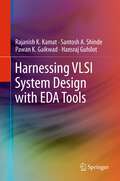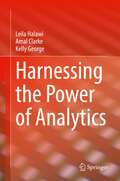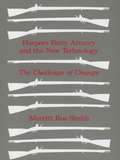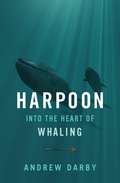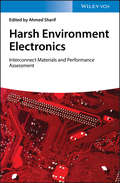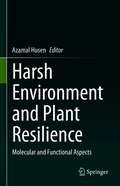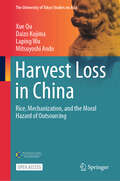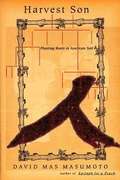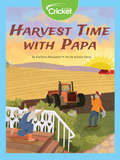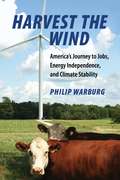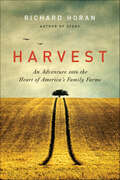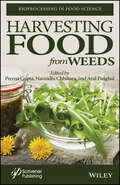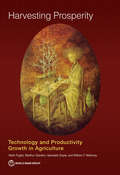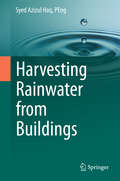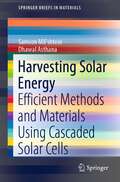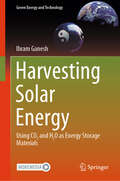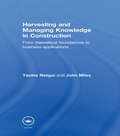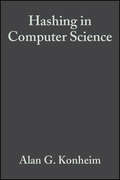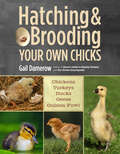- Table View
- List View
Harnessing Sesuvium Portulacastrum for Biosaline Agriculture
by Suprasanna Penna Ganesh Chandrakant NikaljeThis edited book provides a detailed and comprehensive overview of the stress adaptation and utilization of the halophyte Sesuvium portulacastrum in bio-saline agriculture. The book focuses on plant's defense mechanisms to various abiotic stresses, including salt, drought, toxic metals, dyes, effluents, and nutrient deficiency. The book highlights the potential applications of S. portulacastrum in environmental protection, such as, desalination, and phytoremediation. One of the key features of the book is its exploration of the adaptation mechanisms of S. portulacastrum to environmental stresses at morphological, anatomical, physiological, biochemical, molecular, proteomic, and metabolomic levels. This in-depth analysis provides a comprehensive understanding of how Sesuvium withstands harsh environments and, this could potentially serve as a model for investigations on other plants and in developing salt tolerant plants. The book also provides directions for utilizing S. portulacastrum in bio-saline agriculture. The book is a valuable resource for researchers, agronomists, and policymakers interested in developing sustainable agriculture practices in regions affected by salinity and other environmental stresses.
Harnessing Solar Heat
by Brian NortonSystems engineered by man to harness solar heat in a controlled manner now include a diverse range of technologies each serving distinctive needs in particular climate contexts. This text covers the breadth of solar energy technologies for the conversion of solar energy to provide heat, either as the directly-used output or as an intermediary to other uses such as power generation or cooling. It is a wholly updated, extended and revised version of "Solar Energy Thermal Technology" first published in 1992. The text draws on the own author's research and that of numerous colleagues and collaborators at Cranfield University, University of Ulster, Dublin Institute of Technology, Indian Institute of Technology, Delhi and University of Nigeria. The initial chapters deal with relevant fundamental aspects of solar energy meteorology, radiative heat transfer, material properties and energy storage. Solar energy collectors are discussed in detail before a set of chapters deal with each of the full range of applications. The early chapters consider: the solar energy resource, its distribution in geographical, spectral, skyward geometrical and temporal domains; the physics of solar energy absorption, transmission and loss at surfaces; and techniques for storing collected solar energy. Specific collector sub-systems are then discussed in chapters seven to nine. For each system, practical issues are discussed and a proven analytical procedure for predicting performance described. Similarly analyses are presented in the concluding chapters on solar energy systems. These range from dryers to greenhouses to systems that render buildings solar energy systems in themselves and the associated design issues. The context for any use of solar energy is the prevailing climate. This text, being global in scope, definates the most appropriate regions for particular technologies and applications. It is a research-orientated academic work citing publications on the peer-reviewed literature covering engineering and applied science topics intended both for student use, as a reference tool for teaching solar energy and for those researching solar thermal applications in universities, industry or national/commercial laboratories. Insight into the challenges of implementation including practical constraints and operational considerations are provided to aid those undertaking feasibility studies, technical assistance, training assignments or operating testing facilities.
Harnessing Synthetic Nanotechnology-Based Methodologies for Sustainable Green Applications
by Gérrard Eddy Jai Poinern, Suraj Kumar Tripathy and Derek FawcettNanotechnology is at the forefront of many of the latest developments across science and technology, but to generate and deploy these applications, macroscopic levels of nanoscale materials have to be carefully generated whilst remaining cost effective. These materials need to be reliable, consistent, and safe, and as a general principle, industries should consider green sustainable methods in the synthesis of these material and their applications as well. This book introduces readers to the field of green nanotechnologies and their possible applications to create a safer world. This accessible and practical guide will be a useful resource for material scientists, engineers, chemists, biotechnologists, and scientists working in the space of nanomaterials, in addition to graduate students in physics, chemistry, biomedical sciences and engineering. THIS BOOK Presents an accessible introduction to the topic in addition to more advanced material for specialists in the field. Covers a broad spectrum of topics in this new field. Contains exciting case studies and examples, such as quantum dots, bionanomaterials, and future perspectives. Dr Gérrard E.J. Poinern holds a Ph.D. in Physics from Murdoch University, Western Australia and a Double Major in Physics and Chemistry. Currently he is an Associate Professor in Physics and Nanotechnology in the School of Engineering and Information Technology at Murdoch University. He is the director of Murdoch Applied Innovation and Nanotechnology Research Group, Murdoch University. In 2003, he discovered and pioneered the use of an inorganic nanomembrane for potential skin tissue engineering applications. He is the recipient of a Gates Foundation Global Health Grand Challenge Exploration Award for his work in the development of biosynthetic materials and their subsequent application in the manufacture of biomedical devices. He is also the author of the 2014 CRC Press experimental textbook "A Laboratory Course in Nanoscience and Nanotechnology". Associate Professor Suraj Kumar Tripathy is Associate Dean of the School of Chemical Technology at Kalinga Institute of Industrial Technology, Bhubaneswar, India. He currently leads the Chemical & Bioprocess Engineering Lab (CBEL) at KIIT which focuses on achieving sustainability in materials processing and utilization. CBEL explores opportunities in valorization of waste materials (secondary resources) and investigate their applications in catalysis, water treatment, and biomedical systems. CBEL also works closely with industries to develop suitable waste management and resource recycling strategies to optimize the potential of circular economy model. Dr. Derek Fawcett is the Defence Science Centre research fellow at Murdoch University, Australia. His research involves the investigation and development of new advanced materials and their use in innovative engineering systems. He has published over seventy peer-reviewed research papers in international journals and is the co-author of four book chapters on applied nanotechnology.
Harnessing Technology for Deeper Learning
by Scott McLeod; Julie GraberSeeking a New Approach; Introducing the 4 Shifts Protocol; Redesigning Elementary School Lessons and Units; Redesigning Secondary Lessons and Units; Designing From Standards; Implementing the Protocol Tips, Strategies, and Other Suggestions.
Harnessing VLSI System Design with EDA Tools
by Hansraj Guhilot Santosh A. Shinde Pawan K. Gaikwad Rajanish K. KamatWith the proliferation of VHDL, the reference material also grew in the same order. Today there is good amount of scholarly literature including many books describing various aspects of VHDL. However, an indepth review of these books reveals a different story. Many of them have emerged simply as an improved version of the manual. While some of them deal with the system design issues, they lack appropriate exemplifying to illustrate the concepts. Others give large number of examples, but lack the VLSI system design issues. In nutshell, the fact which gone unnoticed by most of the books, is the growth of the VLSI is not merely due to the language itself, but more due to the development of large number of third party tools useful from the FPGA or semicustom ASIC realization point of view. In the proposed book, the authors have synergized the VHDL programming with appropriate EDA tools so as to present a full proof system design to the readers. In this book along with the VHDL coding issues, the simulation and synthesis with the various toolsets enables the potential reader to visualize the final design. The VHDL design codes have been synthesized using different third party tools such as Xilinx Web pack Ver.11, Modelsim PE, Leonrado Spectrum and Synplify Pro. Mixed flow illustrated by using the above mentioned tools presents an insight to optimize the design with reference to the spatial, temporal and power metrics.
Harnessing the Power of Analytics
by Leila Halawi Amal Clarke Kelly GeorgeThis text highlights the difference between analytics and data science, using predictive analytic techniques to analyze different historical data, including aviation data and concrete data, interpreting the predictive models, and highlighting the steps to deploy the models and the steps ahead. The book combines the conceptual perspective and a hands-on approach to predictive analytics using SAS VIYA, an analytic and data management platform. The authors use SAS VIYA to focus on analytics to solve problems, highlight how analytics is applied in the airline and business environment, and compare several different modeling techniques. They decipher complex algorithms to demonstrate how they can be applied and explained within improving decisions.
Harpers Ferry Armory and the New Technology: The Challenge of Change
by Merritt Roe SmithFocusing on the day-to-day operations of the U.S. armory at Harpers Ferry, Virginia, from 1798 to 1861, this book shows what the "new technology" of mechanized production meant in terms of organization, management, and worker morale. A local study of much more than local significance, it highlights the major problems of technical innovation and social adaptation in antebellum America. Merritt Roe Smith describes how positions of authority at the armory were tied to a larger network of political and economic influence in the community; how these relationships, in turn, affected managerial behavior; and how local social conditions reinforced the reactions of decision makers. He also demonstrates how craft traditions and variant attitudes toward work vis-à-vis New England created an atmosphere in which the machine was held suspect and inventive activity was hampered. Of central importance is the author's analysis of the drastic differences between Harpers Ferry and its counterpart, the national armory at Springfield, Massachusetts, which played a pivotal role in the emergence of the new technology. The flow of technical information between the two armories, he shows, moved in one direction only-- north to south. "In the end," Smith concludes, "the stamina of local culture is paramount in explaining why the Harpers Ferry armory never really flourished as a center of technological innovation." Pointing up the complexities of industrial change, this account of the Harpers Ferry experience challenges the commonly held view that Americans have always been eagerly receptive to new technological advances.
Harpoon: Into the Heart of Whaling (A Merloyd Lawrence Book)
by Andrew DarbyThe awe-inspiring history of whales and whaling, and todayOCOs epic struggle to end the slaughter"
Harry I Was?!
by Patriots Point Education DepartmentJoin Harry Smith and his family as they experience truly historic events in American history. These stories and letters take you on a journey through important events from the Civil War through the Space Race!
Harsh Environment Electronics: Interconnect Materials and Performance Assessment
by Ahmed SharifProvides in-depth knowledge on novel materials that make electronics work under high-temperature and high-pressure conditions This book reviews the state of the art in research and development of lead-free interconnect materials for electronic packaging technology. It identifies the technical barriers to the development and manufacture of high-temperature interconnect materials to investigate into the complexities introduced by harsh conditions. It teaches the techniques adopted and the possible alternatives of interconnect materials to cope with the impacts of extreme temperatures for implementing at industrial scale. The book also examines the application of nanomaterials, current trends within the topic area, and the potential environmental impacts of material usage. Written by world-renowned experts from academia and industry, Harsh Environment Electronics: Interconnect Materials and Performance Assessment covers interconnect materials based on silver, gold, and zinc alloys as well as advanced approaches utilizing polymers and nanomaterials in the first section. The second part is devoted to the performance assessment of the different interconnect materials and their respective environmental impact. -Takes a scientific approach to analyzing and addressing the issues related to interconnect materials involved in high temperature electronics -Reviews all relevant materials used in interconnect technology as well as alternative approaches otherwise neglected in other literature -Highlights emergent research and theoretical concepts in the implementation of different materials in soldering and die-attach applications -Covers wide-bandgap semiconductor device technologies for high temperature and harsh environment applications, transient liquid phase bonding, glass frit based die attach solution for harsh environment, and more -A pivotal reference for professionals, engineers, students, and researchers Harsh Environment Electronics: Interconnect Materials and Performance Assessment is aimed at materials scientists, electrical engineers, and semiconductor physicists, and treats this specialized topic with breadth and depth.
Harsh Environment and Plant Resilience: Molecular and Functional Aspects
by Azamal HusenIn the recent past, threats from climate change and unforeseeable environmental extremes to plant growth and productivity have consistently increased. The climate change-driven effects, especially from unpredictable environmental fluctuations, can result in an increased prevalence of abiotic and biotic stresses in plants. These stresses have slowed down the global yields of crop plants. On the other hand, food security for the rapidly growing human population in a sustainable ecosystem is a major concern of the present-day world. Thus, understanding the core developmental, physiological and molecular aspects that regulate plant growth and productivity in a challenging environment is a pivotal issue to be tackled by the scientific community dealing with sustainable agricultural and horticultural practices. Plants are influenced by the adverse environmental conditions at various levels, their different and diverse responses play a significant role in determining their growth, production and the overall geographical distribution. The chapters in this book focus on the biological mechanisms and fundamental principles that determine how different plant species grow, perform and interact with a challenging environment. This book covers a broad range of topics in plant science, including gene function, molecules, physiology, cell biology and plant ecology, to understand the functioning of plants under harsh environmental conditions. The book elucidates the physiological and molecular mechanisms in different plant species, ecophysiological interactions of plants, interplay between plant roots, arbuscular mycorrhizal fungi and plant growth-promoting rhizobacteria, biosensors for monitoring stress, production of secondary metabolites, stress alleviation processes, and more.
Hartman's Complete Guide for the EKG Technician
by Wilma Lynne ClarkeThis Clear, concise, and up-to-date, Guide will help students master the skills and knowledge they need to pass EKG technician certification exams and to excel on the job. Unlike many EKG interpretation texts, this book is written specifically for students taking EKG technician courses or working toward EKG technician certification. <p><p> Presents basic anatomy, physiology, and pathophysiology in a way that relates clearly to the work of EKG technicians; Introduces EKG technology and the interpretation of the EKG in clear, organized steps; Provides step-by-step instructions for patient care and EKG testing procedures; Offers detailed, full-color photos and illustrations throughout the book; Contains over 100 practice exercises in the rhythm identification chapter, giving students the opportunity to view and interpret actual EKG tracings; Includes tip boxes, quick reference charts, chapter reviews, and a glossary to help students identify and focus on key material; Covers infection prevention, communication skills, scope of practice, and ethics as these subjects relate to the role of EKG technicians; Instructor's material includes over 100 additional EKG interpretation exercises, a practice certification exam, critical thinking activities, and test-taking tips.
Harvest Loss in China: Rice, Mechanization, and the Moral Hazard of Outsourcing (The University of Tokyo Studies on Asia)
by Xue Qu Daizo Kojima Laping Wu Mitsuyoshi AndoThis open access book examines food security in China with a specific focus on rice harvesting. As the most populous agricultural developing country, China’s food security is closely related to the world’s food security. An urgent issue internationally, data show that every year, about one-third of food is lost and wasted before it even reaches the market, mainly in less developed countries. To this end, halving the amount of food loss and waste is one of the Sustainable Development Goals. In 2021, the Chinese government issued the Anti-Food Waste Law of the People’s Republic of China, placing a high priority on food loss reduction. Rice, one of the major staple foods, has also received a higher priority in government policy, as it has been deemed required to be “absolutely safe”. In China, rice farmers rely heavily on outsourcing services to complete harvesting, which has led to the rapid development of mechanical harvesting. This book shows that the essence of outsourcing services is a principal–agent relationship in which there is a potential moral hazard, which is considered detrimental to harvest losses. The book analyses the effect of the moral hazard in harvest outsourcing services on rice harvest losses from this principal–agent theoretical perspective. Using the latest nationwide farmer survey, it empirically demonstrates the moral hazard in agricultural outsourcing services and its negative impact on harvest losses, providing suggestions for food loss reduction in China and similar developing countries where agricultural outsourcing services are developing rapidly. Relevant to social science researchers working in areas of food security in connection with the SDGs, and to scholars studying development in China more generally, this is a timely contribution confronting possible means of food loss reduction, in the developing world particularly, in the East, and globally.
Harvest Son: Planting Roots in American Soil
by David Mas MasumotoA Japanese-American farmer offers a tribute to family, farm and community. In prose of zen-like calm and clarity, Masumoto relates how he learned how to prune vines and survive a storm; to value the knowledge of old farmers and rusty tools; and to take on a leadership role in his Buddhist community.
Harvest Time with Papa
by Karilynn BenjaminA girl helps her papa harvest grain on their wheat farm in Montana. She drives in the combine, and learns that wheat is made up of kernels and chaff.
Harvest the Wind: America's Journey to Jobs, Energy Independence, and Climate Stability
by Philip WarburgWinds sweeping across the Great Plains once robbed the Farm Belt of its future, stripping away overworked topsoil and creating the dreaded Dust Bowl of the 1930s. Today, those winds are bringing new hope to the declining rural communities of the central United States. Nowhere is wind's promise more palpable than in Cloud County, Kansas, home to the Meridian Way Wind Farm, whose turbines are boosting farm incomes and bringing green jobs to a community that has watched its children flock elsewhere. Modern wind power is the best thing to hit this stretch of midwestern prairie since the Union Pacific railroad.In Harvest the Wind, Warburg brings us the people behind the green economy-powered resurgence in Cloud County and communities like it across the United States. This corner of Kansas is the first stop on an odyssey that introduces readers to farmers, factory workers, biologists, and high-tech entrepreneurs--all players in a transformative industry that is taking hold across America and around the globe.Harvest the Wind serves as an earthly antidote to the more abstract treatises on global warming and green energy. By showing us how practical solutions are being implemented at the local level, Warburg offers an inspirational look at how we can all pursue a saner and more sustainable energy future.
Harvest: An Adventure into the Heart of America's Family Farms
by Richard Horan“Richard Horan has brought us a welcome view of America to defy the prevailing political and financial nastiness. This is a timely and important book.”—Ted Morgan, author of Wilderness at Dawn“A lively visit with the dauntless men and women who operate America’s family farms and help provide our miraculous annual bounty. Richard Horan writes with energy and passion.”—Hannah Nordhaus, author of The Beekeeper’s Lament“Horan’s new book evocatively describes the peril and promise of family farms in America. I loved joining him on this journey, and so will you.”—T.A. Barron, author of The Great Tree of AvalonIn Seeds, novelist and nature writer Richard Horan sought out the trees that inspired the work of great American writers like Faulkner, Kerouac, Welty, Wharton, and Harper Lee. In Harvest, Horan embarks upon a serendipitous journey across America to work the harvests of more than a dozen essential or unusual food crops—and, in the process, forms powerful connections with the farmers, the soil, and the seasons.
Harvesting Food from Weeds
by Navnidhi Chhikara Anil Panghal Prerna GuptaHARVESTING FOODS from WEEDS Food science is a rapidly changing and complicated subject. This new series addresses the current state-of-the-art concepts and technologies associated with the industry and will cover new ideas and emerging novel technologies and processes. With the world’s population continuing to grow exponentially, with many “food deserts” across the globe, including even in rich countries, food production is more important than ever. Finding alternative ways to produce food, in a sustainable way, is increasingly important and something that is on the minds of scientists, engineers, policy makers, and other professionals. Weeds are mainly undesirable plants, but nowadays researchers are exploring these weeds as a food source. Weeds can also grow in adverse climatic conditions with minimum nutritional requirements. Weeds that are rich in nutrients and bioactive compounds are suitable ingredients for functional foods and meet nutritional requirements at a cheaper cost and thus are lucrative and attractive for the food industry. This latest volume in the groundbreaking series, “Bioprocessing in the Food Industry,” covers different types of weeds, like eleusine indica, tribulus terrestris, hibiscus cannabinus, corchorus, gynandra gynandropsis, and many others. These weeds have limited food applications, mainly because of traditional food production. This book will provide detailed knowledge regarding the nutritional value, health benefits and processing methods of these weeds. Readers will learn how these weeds can be utilized for food production, healthy food development, and sustainability. Combining the technological requirements, food safety and quality, this book showcases the utilization of modern technologies to process food products with great benefits. The volume will comprehensively meet the knowledge requirements for the curriculum of undergraduate, postgraduate and research students for learning the concepts of bioprocessing in food engineering, as well as veteran engineers, policy makers, scientists, chemists, and other industry professionals. It is a must have for any library.
Harvesting Prosperity: Technology and Productivity Growth in Agriculture
by Maloney Aparajita Goyal Keith Fuglie Madhur GautamBack cover blurb Rising agricultural productivity has driven improvements in living standards for millennia. Today, redoubling that effort in developing countries is critical to reducing extreme poverty, ensuring food security for an increasing global population, and adapting to changes in climate. This volume presents fresh analysis on global trends and sources of productivity growth in agriculture and offers new perspectives on the drivers of that growth. It argues that gains from the reallocation of land and labor are not as promising as believed, so policy needs to focus more on the generation and dissemination of new technologies, which requires stepping up national research efforts. Yet, in many of the poorest nations, a serious research spending gap has emerged precisely at the time when the challenges faced by agriculture are intensifying. The book focuses on how this problem can be redressed in the public sector, as well as on reforms aimed at mobilizing new private sector actors and value chains, particularly creating a better enabling environment, reforming trade regulations, introducing new products, and strengthening intellectual property rights. On the demand side, the book examines what recent research reveals about policies to reduce the barriers impeding smallholder farmers from adopting new technologies. Harvesting Prosperity is the fourth volume of the World Bank Productivity Project, which seeks to bring frontier thinking on the measurement and determinants of productivity to global policy makers. “As rightly argued by the authors, growth in agricultural productivity is the essential instrument to promote development in low-income agriculture-based countries. Achieving this requires research and development, upgrading of universities, reinforcement of farmer capacities, removal of constraints to adoption, and the development of inclusive value chains with interlinked contracts. As important, such efforts also need to be placed within a context of comprehensive agricultural, rural, and structural transformations. However, in many countries implementation of the requisite policies has been lagging. This book, with contributions from many top experts in the field, provides the most up-to-date presentation of this argument and explains in detail how to successfully put its ideas into practice. Governments, the private sector, and civil society organizations need to study it carefully to turn the promise of agriculture for development into a reality.“ Alain de Janvry and Elisabeth Sadoulet Professors of the Graduate School, University of California at Berkeley
Harvesting Rainwater from Buildings
by Syed Azizul HaqThe present book describes in detail all aspects of rainwater harvesting, including the basic concepts, procedures, opportunities and practice of rainwater harvesting mainly focusing its application in buildings of various occupancies and sizes. It provides a user-friendly methodology for the planning, design, construction and maintenance of rainwater harvesting infrastructure, in buildings and its premise, as a supplement to conventional water supplies. It highlights the application of plumbing technology, which is an important aspect of rainwater harvesting in buildings. It also includes global rainfall scenario and brief notes on all the elements of rainwater harvesting used in buildings. It is a valuable reference resource for policy and decision-makers, as well as for engineers, architects and students.
Harvesting Solar Energy: Efficient Methods and Materials Using Cascaded Solar Cells (SpringerBriefs in Materials)
by Samson Mil'shtein Dhawal AsthanaThis book deals with existing technologies of solar energy conversion as well as novel methods under consideration in academic and commercial R&D sites. The experimental results presented in the work are well crafted by both analytical and first-principle numerical simulations. The book highlights the real potential for economically justified use of solar energy at every household and/or commercial solar farms. The ever-improving methods of thin-film epitaxial growth combined with a better understanding of the sun light absorption and antireflection are highlighted. While there was a period when the material quality was considered to be cornerstone of the conversion efficiency followed by substantial efforts to optimize multiple-cell architecture, it became clear that many old ideas such as variable band gap, multi-junction intrinsic region, as well as solar tracking mechanisms offer new possibilities for improved harvesting of energy. Amplifying the importance of materials selection efficient design of the photo-voltaic elements various aspects of the production cost and the impact on the environment are discussed. In addition, the eligibility of the proposed production technologies in the current photovoltaic market are evaluated and confirmed.
Harvesting Solar Energy: Using CO₂ and H₂O as Energy Storage Materials (Green Energy and Technology)
by Ibram GaneshThis book presents artificial photosynthesis (AP) that facilitates the capture and storage of solar energy in order to meet our energy needs. Furthermore, renewable carbon-neutral high-energy-density liquid fuels used in the present existing energy distribution infrastructure can also be synthesized by following the AP process using carbon dioxide, water, and electricity derived from sunlight. The only way to make energy, environment, economy, and life sustainable is to harvest sunlight to meet the energy needs of society by using carbon dioxide and water as for energy storage.
Harvesting and Managing Knowledge in Construction: From Theoretical Foundations to Business Applications
by John Miles Yacine RezguiA successful construction business is a knowledge business. And knowledge must be managed effectively to be used efficiently, especially in a complex project-oriented business such as construction, where skills acquired and lessons learned on one project need to be applied to the next. A holistic approach to knowledge management (KM) is taken in this book to incorporate all of the relevant themes, tackling technological, socio-cultural and organizational issues, with the creation of value as a focus throughout. Information is drawn from a broad range of sources to explain core theories and provide guidance on practical application. Topics covered include: changing business relationships in a knowledge economy knowledge creation processes and theories data, text and knowledge mining techniques the learning construction organization future technology for knowledge management. Written by the authors of the first EU-funded KM research project in the field of construction, this textbook is uniquely well-researched, and is the perfect introduction to KM for students across the built environment. It is also a crucial guide to the topic for practitioners.
Hashing in Computer Science
by Alan G. KonheimWritten by one of the developers of the technology, Hashing is both a historical document on the development of hashing and an analysis of the applications of hashing in a society increasingly concerned with security. The material in this book is based on courses taught by the author, and key points are reinforced in sample problems and an accompanying instructor s manual. Graduate students and researchers in mathematics, cryptography, and security will benefit from this overview of hashing and the complicated mathematics that it requires.
Hatching & Brooding Your Own Chicks: Chickens, Turkeys, Ducks, Geese, Guinea Fowl
by Gail DamerowGail Damerow shows you how to incubate, hatch, and brood baby chickens, ducklings, goslings, turkey poults, and guinea keets. With advice on everything from selecting a breed and choosing the best incubator to feeding and caring for newborn chicks in a brooder, this comprehensive guide also covers issues like embryo development, panting chicks, and a variety of common birth defects. Whether you want to hatch three eggs or one hundred, you’ll find all the information you need to make your poultry-raising operation a success.
